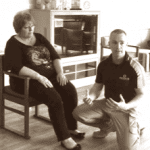Managing Distressed Behaviours with Older People in Care – Hygiene Tasks
Managing Distressed Behaviours, particularly with Residents presenting combative resistance to basic personal hygiene care is an increasingly common scenario in care homes for older people that we visit, in our training team’s experience. Staff should have clear guidance on when and how this scenario is to be managed, including specific instructions about the procedures to be carried out for Managing Distressed Behaviours.
Let’s look at some guidance:
“Force may be necessary to provide basic care. For example, a person with dementia who develops incontinence may resist interventions to provide basic hygiene and skin care. Bathing and showering with the use of force or restraint may cause distress, and may need to be less frequent than might be ideal. On the other hand, the person may suffer and be stigmatised because of poor hygiene. Caregivers must strike a balance and only use force where necessary and proportionate. Repeated use of force is likely to need formal legal authority.”
Mental Welfare Commission for Scotland: Right toTreat?
KEY ISSUES:
1) Creative Approaches? Are the staff being given in-depth, appropriate and relevant training in Managing Distressed Behaviours? For example, there is an excellent training programme called “Bathing without a Battle” from the USA which explores the whole issue of resistance during attempts to bathe elderly service users in care services. Are carers being exposed to these ideas? Are managers giving their care staff the opportunities and the responsibility to creatively approach these scenarios and to find the best, person-directed pathway for achieving the goal of cleanliness? [click here to see our video summary of the key ideas in Bathing without a Battle]
2) Risk Assessment: The manual handling considerations (in particular) for physically restraining a resident who is resisting urgent and necessary intimate personal care should be addressed by a comprehensive risk assessment and a detailed person-centred restraint protocol. Are the staff in the home competent to carry out this Managing Distressed Behaviours assessment? Does the team have sufficient expertise in Behaviour, Communications, Physical Interventions to carry out the intervention professionally?
3) Staffing: Are there enough staff available to carry out any such intervention safely? A deficit in the numbers of staff necessary to carry out a particular intervention safely will not be any kind of defence to any charges which might arise if an intervention is carried out ineptly and perhaps causes an injury to the resident or to the staff.
4) The scenario is Forseeable and therefore needs a Risk Assessment: Where a resident is soiled and needs the attention of care staff to get cleaned up, but resists verbally and physically their efforts to do so, then we believe it is important that every step of the process to manage this scenario is managed in a clear, ordered and auditable way. We believe that this kind of Managing Distressed Behaviours incident is foreseeable and it carries high risk, therefore it should be properly risk assessed and is likely to need a formal, written procedure and protocol for the times when it is invoked.
5) Time Issues in the Intervention: Often when we see that this scenario has been recognised and is frequently being encountered by staff, then we see that the care plan for the resident has included it. However, we often find that the care plan is vague on details, for example it will stipulate that 2 or 3 staff must work with the resident to get them clean (under resistance if necessary and when all other options have been exhausted, of course) BUT the care plan rarely describes the procedure or methods which the staff should use to achieve the task. What often results is a hodgepodge of different ways to wrestle the resident into various positions with one member of staff risking injury herself in attempting to clean the subject while dodging blows and enduring scratches and pinches….all of which takes many minutes of high anxiety and stress for both the service user and the staff. Our advice is that: If force is required, it should be used to achieve its aim skilfully. Maximum certainty, minimum movement time and minimum energy expenditure – Guthrie’s Law. If force is used skilfully in this scenario, then it is likely to require less time, less energy and therefore greater safety and security for all involved, so why is the detail so often missing in the care plan?
—————————————————————-
Gerard O’Dea is a conflict management, personal safety and physical interventions training consultant, helping care home staff and managers in Managing Distressed Behaviours professionally and efficiently while treating everyone involved with dignity and showing them respect. He is the training director for Dynamis, a specialist provider of personal safety and violence management programmes and the European Adviser for ‘Verbal Defense and Influence’, a global programme which addresses the spectrum of human conflict. www.dynamis.training
For more information:



